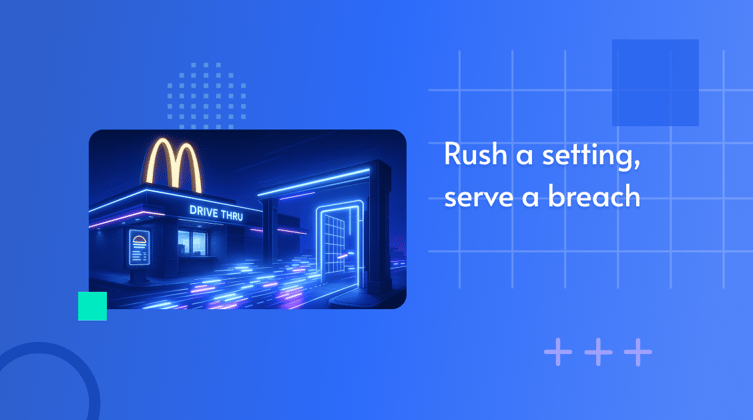Security leaders invest heavily in the front door: phishing defenses, malware de...
From Burgers to Breaches: What McDonald’s Data Leak Can Teach Us

Security teams are constantly walking a tightrope — enabling growth while minimizing risk. Most eyes are on the usual suspects: ransomware gangs, zero-day exploits, phishing campaigns. But too often, biggest risk is already inside, hiding in plain sight.Today, misconfigurations are among the most common — and most preventable — causes of breaches. Take the recent McDonald’s job applicant data leak, a textbook example of how a flimsy configuration can negate all your other security measures overnight.
In this case, it was a misconfigured admin portal on McHire, the yellow arches' AI-powered recruiting platform. Protected only by a default username and password — both set to “123456” — it was the cybersecurity equivalent of an open drive-thru lane.
It’s the kind of breach that feels more like a punchline than a sophisticated cyberattack and yet the human cost was real: it exposed résumés, names, emails, phone numbers, and even internal business documents.
The result? A supersized reputational hit for everyone involved. And a grim reminder that “secure by design” doesn't work when generic defaults are left in place. After all, with credentials like "123456," the breach it doesn't take a brilliant hacker cause harm.
Misconfigurations, Not Masterminds
The truth is that no one plans to leave systems misconfigured.
Changing a setting might fix a vulnerability, but it could also break an application, halt a service, or frustrate a critical business unit. That fear creates a dangerous tension or even paralysis: teams hesitate to act, hoping that they won't pay the price for their laxness. This leads to situations like:
-
Default passwords remaining in place.
-
Admin portals exposed with weak or no authentication.
-
Print Spooler is needlessly enabled on unauthorized devices.
When people move fast, prioritize convenience over control, implement changes on the fly, and never circle back to validate or document, you get gaps. And without real-time, shared visibility, those gaps tend to grow — eventually exploding into crises.
Then there’s the fact that hardening configurations presents the very real risk of breaking functionality. Really anytime you push a change to production, you risk upsetting the carefully calibrated mechanics that keep things running and have been refined over years. This creates a lose-lose choice between today’s business operations and tomorrow’s (often hypothetical) security risks. Facing that dilemma, today typically wins out. And risk continues to accumulate.
Left unresolved, these “small” missteps snowball into long-term technical debt — silently accumulating until one day, they go boom. What makes these breaches especially painful isn’t just the data exposed. It’s also how utterly avoidable they are.
From Reactive Cleanup to Confident, Proactive Control
As we've seen time and time again, misconfigurations put your organization at serious risk — and delaying action only compounds the problem. What starts as a fixable misstep becomes embedded technical debt that weakens your foundations.
It’s time to treat configuration as core to business resilience. Here’s how to strengthen resilience and reduce risk, one step at a time:
-
Continuously Monitor Configuration States
You can’t fix what you can’t see. Organizations need continuous, real-time insight into how every system, setting, and endpoint is configured.
-
Automate Detection and Remediation
Manual checks don’t scale, especially in enterprise environments. Automate the identification of risky configurations (while allowing for human oversight). Make remediation safe, fast, and seamless — without disrupting workflows.
-
Prioritize Fixes for High-Risk Misconfigurations
Not every setting is equal. Focus on configurations that open paths to ransomware, lateral movement, or unauthorized access — things like legacy protocols and excessive permissions.
Misconfigurations can be complex and challenging, especially at scale. But they're also fixable. With the right approach, you can turn configurations from a weakness to a strength.
Remedio, for example, gives organizations unified visibility across their IT, OT, on-prem, and cloud environments — regardless of operating system and without conflicts between device settings, domain controls, rule priority, or custom scripts.
Remedio is also smart enough to prioritize issues based on real-world exploitability, business impact, and compliance requirements. Best of all, it allows you proactively improve your posture with safe, pre-validated remediations that won’t break systems or disrupt business operations.
Here's the cherry on top of the McSundae — it doesn't need to be an uphill battle. With Remedio, it's both scalable and sustainable. The platform studies your environment and the actions you're undertaking to recommend related measures that can be rolled into planned changes — giving you more bang for your buck and streamlining hardening workflows.
Crucially, Remedio also makes sure there's no daylight between your security intentions and implementations. Whether through altered groupings, new devices, user changes, or software updates, its fairly common for configuration states to drift from secure baselines. Remedio puts a stop to that by allowing users to auto-reapply any approved actions — ensuring that the reality in the field always matches your specifications; today, tomorrow, and as long as needed.
And that can make all the difference. After all, the McDonald’s breach wasn’t some elite cyber takedown — it was a basic oversight that could have happened pretty much anywhere and to any company. It's a harsh reminder that misconfigurations don’t just create risk; they quietly erode trust, reputation, and control.
Because when it comes to misconfigurations, the last thing your business needs… is a side order of breach.
About Author

Linda Ivri
Fueled by curiosity, Linda is a senior marketer who thrives on decoding the complex challenges where cybersecurity meets business operations.
Subscribe to
our Newsletter
We are ready to help you until and unless you find the right ladder to success.
Related Posts
Join over 25,000 in beating the failure of strategies by following our blog.
If a threat falls in the SOC and no one ties it to revenue, does it really make ...
7 minute read
Picture the legendary Metropolitan Opera House on opening night. The air hums wi...
6 minute read
In cybersecurity, the smallest missteps can lead to the biggest breaches. Take B...








Comments